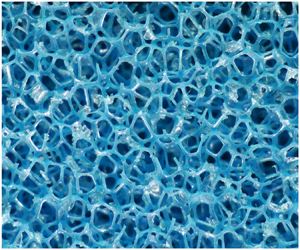Article contents
Direct effects of boundary permeability on turbulent flows: observations from an experimental study using zero-mean-shear turbulence
Published online by Cambridge University Press: 31 March 2021
Abstract

The interaction of zero-mean-shear turbulence (generated using an oscillating grid) with solid and permeable boundaries is studied experimentally. The influence of wall permeability is characterised using the permeability Reynolds number,  $Re_K$, which represents the ratio of the typical pore size in the permeable medium to a viscous length scale. Instantaneous velocity measurements, obtained using two-dimensional particle imaging velocimetry, are used to study the effect boundary permeability has on the root mean square of fluctuating velocity components, the vertical flux of turbulent kinetic energy (TKE) and conditional turbulent statistics associated with events in which intercomponent energy transfer is concentrated. When
$Re_K$, which represents the ratio of the typical pore size in the permeable medium to a viscous length scale. Instantaneous velocity measurements, obtained using two-dimensional particle imaging velocimetry, are used to study the effect boundary permeability has on the root mean square of fluctuating velocity components, the vertical flux of turbulent kinetic energy (TKE) and conditional turbulent statistics associated with events in which intercomponent energy transfer is concentrated. When  $Re_K \lesssim 0.2$ the boundary acts as if it were impermeable; results indicate the interaction is dominated by the kinematic blocking effect of the boundary on the boundary-normal TKE flux, with additional mechanisms acting through intercomponent energy transfer. The results show these mechanisms are inhibited as
$Re_K \lesssim 0.2$ the boundary acts as if it were impermeable; results indicate the interaction is dominated by the kinematic blocking effect of the boundary on the boundary-normal TKE flux, with additional mechanisms acting through intercomponent energy transfer. The results show these mechanisms are inhibited as  $Re_K$ increases, due to the transportation of turbulent energy into the porous medium as the macroscopic blocking condition is relaxed, thereby reducing TKE within the boundary-affected region and inhibiting the formation of high-pressure stagnation events that are responsible for intercomponent energy transfer. The results illustrate how the turbulence structure above a permeable boundary is sensitive to the blocking effect on the boundary-normal turbulent velocity. In light of these results, we propose that further analysis is required to establish the validity of a commonly used model of the boundary conditions enforced at the boundary of porous media, in which a no-penetration boundary condition on the boundary-normal velocity component is proposed.
$Re_K$ increases, due to the transportation of turbulent energy into the porous medium as the macroscopic blocking condition is relaxed, thereby reducing TKE within the boundary-affected region and inhibiting the formation of high-pressure stagnation events that are responsible for intercomponent energy transfer. The results illustrate how the turbulence structure above a permeable boundary is sensitive to the blocking effect on the boundary-normal turbulent velocity. In light of these results, we propose that further analysis is required to establish the validity of a commonly used model of the boundary conditions enforced at the boundary of porous media, in which a no-penetration boundary condition on the boundary-normal velocity component is proposed.
Information
- Type
- JFM Papers
- Information
- Copyright
- © The Author(s), 2021. Published by Cambridge University Press
References
REFERENCES
- 5
- Cited by


